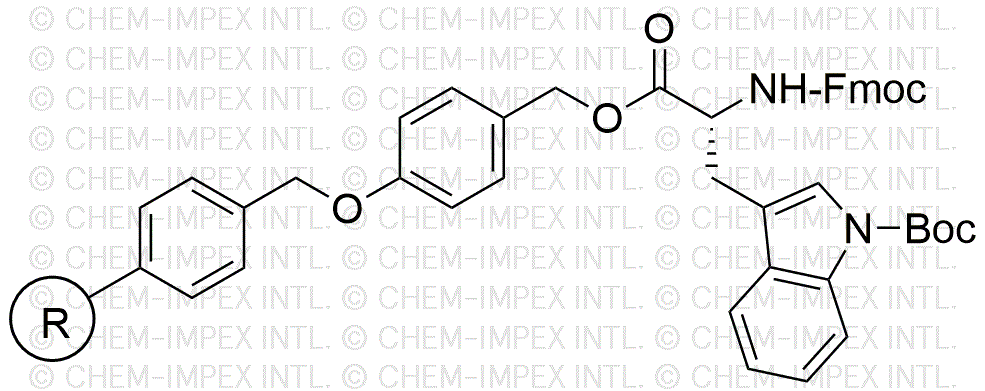Na-Fmoc-Nin-Boc-D-tryptophan 4-alkoxybenzyl alcohol resin is widely utilized in research focused on:
- Peptide Synthesis: This resin serves as a solid support for the synthesis of peptides, allowing for efficient coupling reactions and easy cleavage of the final product.
- Drug Development: It plays a crucial role in the development of peptide-based therapeutics, enabling researchers to create novel compounds with potential pharmaceutical applications.
- Bioconjugation: The resin can be used to attach peptides to various biomolecules, facilitating the creation of targeted drug delivery systems.
- Research in Neuroscience: Its application in synthesizing neuropeptides aids in studying neurological functions and developing treatments for neurodegenerative diseases.
- Customization of Peptide Libraries: This resin allows for the rapid generation of diverse peptide libraries, which are essential for screening and identifying bioactive compounds.
General Information
Properties
Safety and Regulations
Applications
Na-Fmoc-Nin-Boc-D-tryptophan 4-alkoxybenzyl alcohol resin is widely utilized in research focused on:
- Peptide Synthesis: This resin serves as a solid support for the synthesis of peptides, allowing for efficient coupling reactions and easy cleavage of the final product.
- Drug Development: It plays a crucial role in the development of peptide-based therapeutics, enabling researchers to create novel compounds with potential pharmaceutical applications.
- Bioconjugation: The resin can be used to attach peptides to various biomolecules, facilitating the creation of targeted drug delivery systems.
- Research in Neuroscience: Its application in synthesizing neuropeptides aids in studying neurological functions and developing treatments for neurodegenerative diseases.
- Customization of Peptide Libraries: This resin allows for the rapid generation of diverse peptide libraries, which are essential for screening and identifying bioactive compounds.
Documents
Safety Data Sheets (SDS)
The SDS provides comprehensive safety information on handling, storage, and disposal of the product.
Product Specification (PS)
The PS provides a comprehensive breakdown of the product’s properties, including chemical composition, physical state, purity, and storage requirements. It also details acceptable quality ranges and the product's intended applications.
Certificates of Analysis (COA)
Search for Certificates of Analysis (COA) by entering the products Lot Number. Lot and Batch Numbers can be found on a product’s label following the words ‘Lot’ or ‘Batch’.
*Catalog Number
*Lot Number
Certificates Of Origin (COO)
This COO confirms the country where the product was manufactured, and also details the materials and components used in it and whether it is derived from natural, synthetic, or other specific sources. This certificate may be required for customs, trade, and regulatory compliance.
*Catalog Number
*Lot Number
Safety Data Sheets (SDS)
The SDS provides comprehensive safety information on handling, storage, and disposal of the product.
DownloadProduct Specification (PS)
The PS provides a comprehensive breakdown of the product’s properties, including chemical composition, physical state, purity, and storage requirements. It also details acceptable quality ranges and the product's intended applications.
DownloadCertificates of Analysis (COA)
Search for Certificates of Analysis (COA) by entering the products Lot Number. Lot and Batch Numbers can be found on a product’s label following the words ‘Lot’ or ‘Batch’.
*Catalog Number
*Lot Number
Certificates Of Origin (COO)
This COO confirms the country where the product was manufactured, and also details the materials and components used in it and whether it is derived from natural, synthetic, or other specific sources. This certificate may be required for customs, trade, and regulatory compliance.

